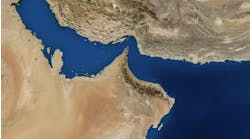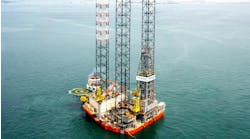Record water depth wells were drilled over a seven-month span in 1999 by Noble Drilling Corporation, and the firm is preparing to set another possible record water depth well during the first half of 2000.
The triangular semisubmersible Noble Paul Wolff recently drilled a well for Petrobras in 8,816 ft of water offshore Brazil. The unit has displayed motion characteristics that have resulted in time and cost savings for Petrobras. To enable the rig to drill in even deeper waters, Noble Drilling is developing an alloy riser that could be as much as 40% lighter than conventional steel risers.
The Noble Paul Wolff was originally a Transworld triangular design submersible rated to work in 100 ft of water in the Gulf of Mexico and other mild climates. Realizing that deepwater is the future, Noble Drilling embarked upon a program to convert six triangular design submersibles into deepwater and ultra-deepwater EVA 4000 design semisubmersibles. The conventionally moored units are rated to drill in up to 6,600 ft water depths. The Noble Paul Wolff, the contractor's only dynamically positioned EVA so far, was designed initially to drill in up to 8,900 ft of water.
That water depth has essentially been reached. "Global Marine set a world water depth record in about 7,700 ft of water in the Gulf of Mexico," said Leo Segerius, Noble Drilling's Vice President of Business Development for Latin America in Brazil. "So 8,000 ft was the barrier that we wanted to take. And then we took it close to 9,000 ft."
Drilling in 10,000 ft
The next step will be to drill in 10,000 ft or more of water. Noble Drilling does not anticipate a significant difference in drilling in 10,000 ft water depth or more, compared to 8,000 ft.
"I don't foresee subsea equipment being problematic in 10,000 ft water depth," Segerius said. "The mud weight could become a problem. There is so much hydrostatic head before you begin drilling that the margins are becoming very small."
"The only constraint we really have is the riser," said Danny Adkins, Vice President of Engineering for Noble Drilling. "We will conduct a design review for drilling in 10,000 feet of water, but we don't anticipate any constraints drilling in that water depth."
Staying over the well
Noble Drilling has not experienced difficulties keeping the Noble Paul Wolff over the wellhead. The rig is kept on station with an array of five acoustic beacons positioned on the seafloor, that signalling transducers beneath the rig. A digital global positioning system (DGPS) is utilized for redundancy, although the DGPS is used to initially locate the desired position.
The control system directs the thrusters to compensate for rig movement caused by ocean or wind conditions and a fiber optic cable system from the controls to the thrusters speeds the response and maximizes stationkeeping capabilities. "At 8,800 ft water depth, we can stay within 8 ft (surface location radius) of the wellhead," Segerius said. "If we really wanted to narrow it down, we could stay within 3-4 ft."
Once on location, the Noble Paul Wolff's motion characteristics are among the most efficient of any rig. The rig is essentially transparent to the wave loadings, partly due to the 16 ft depth of the pontoons compared with other semisubmersibles with deeper pontoons. "One of the unique features of the vessel is its circular holding plot," said Jitendra Prasad, Vice President - Technical for Noble Drilling. "The rig is unbiased in any environmental direction, meaning that, although it is a triangular design, load coming from any direction is about the same." This means it is unnecessary for the rig to change heading if environmental conditions change, unlike other semisubmersibles or with drillships that may need to move 15-20° or more because they can only receive a load from the bow. "To my knowledge, this is the only rig in the world that can do this," Prasad said. "All of our EVA's are that way."
"We have seen 2.5-3.0 knot currents in the Roncador field off Brazil," Segerius added. "And because the Noble Paul Wolff has three bows, we never have to turn. This is a distinct advantage over drillships. At a certain point, a drillship cannot be turned anymore because the moon pool hoses will begin to twist. Then you have to come all the way back and pick up the current again. There are some drillships that do not have the power to turn into the current, if the current is already hitting the side of the vessel," Segerius stated.
Triangular configuration
Noble contends the triangular shape has other efficiencies, when compared with conventional design semisubmersibles. "A square or rectangular dynamically positioned semisubmersible is going to burn around 50 tons of diesel fuel per day with about 35 knot winds and 22 ft waves," Segerius said. "However, the Noble Paul Wolff burns only about 24-25 tons of fuel per day under those same conditions."
There were very few problems associated with drilling in 8,000 ft of water and deeper that were not anticipated during the design and construction phase, Noble states. Solutions were engineered into the design. One slight problem encountered was probably due to the cold temperatures at the seafloor (about 2° C). At those low temperatures, the rubber components in the blowout preventer become less flexible.
"We have had what we think are some temperature-related elastomer problems on some of the ram packers," Adkins added. "However, we don't know for certain if that is the case. The rubber might not be as elastic as what it would be at a higher temperature, but it is nothing that we have not been able to deal with."
"The BOP manufacturer is aware of the situation and they worked very closely with us to overcome the problem," Segerius said.
Reaching objectives
There also have been concerns generally in the industry that, when drilling in deep water, the weight of the mud in the riser and other
factors could result in wells being unable to reach their geological objective. This concern is one of the reasons a riserless drilling concept is being studied. But, to date, drilling operations with the Noble Paul Wolff have reached the
targeted formations with no difficulties.
"It is true that you can run into problems regarding casing," Segerius said. "You have to be very careful when engineering your casing program and where to set the casing. If you set the casing with the first downhole incident or problem, then you could run out of casing. You have to battle any problems and get as close to your original casing point as possible."
The wells drilled so far by the Noble Paul Wolff have not encountered casing problems and each has reached objective. Drilling depth of the first three wells averaged about 16,000 ft.
The Noble Paul Wolff's variable deckload capacity of 5,500 short tons is more than enough to store all the supplies for an ultra-deepwater well. "On any given day, we have to have 25,000 ft of drill pipe, 9,000 ft of riser, 9,000 ft of 9 5/8-in. production tubing, all the different sizes of bottom hole assemblies plus water, mud cement, and chemicals for at least one well," Segerius said. "The wells have been averaging about 30-35 days, including running and pulling the riser."
Noble Drilling has one triangular submersible remaining, the Noble Fri Rodli, to convert to an EVA 4000 with dynamic positioning. That unit would also be capable of working in the 8,000-10,000 ft water depth range.
One of the reasons the EVA design and the Noble Paul Wolff are successful is because of Noble Drilling's engineering effort. "We did not let the vendors do the engineering for us," Prasad said. "We used the knowledge from the vendors, but we did our own engineering."
Adkins agrees: "We spent a lot of time on the stationkeeping analysis, redundancy studies, and riser analysis, and our success is the result of good engineering practices and doing our homework. Noble designed from an operational approach with engineering solutions. The Noble Paul Wolff's success can be attributed to the integrated teamwork of engineering and operational personnel.";
Author
Jerry Greenberg is a Houston-based freelance writer with nearly 20 years experience in the offshore industry, including 13 years as an analyst and reporter. He has worked in marketing and communications for several international offshore drilling contractors. Responses on the issues cited above can be directed to the author at E-mail:[email protected] or Fax: (281) 568-0254.


